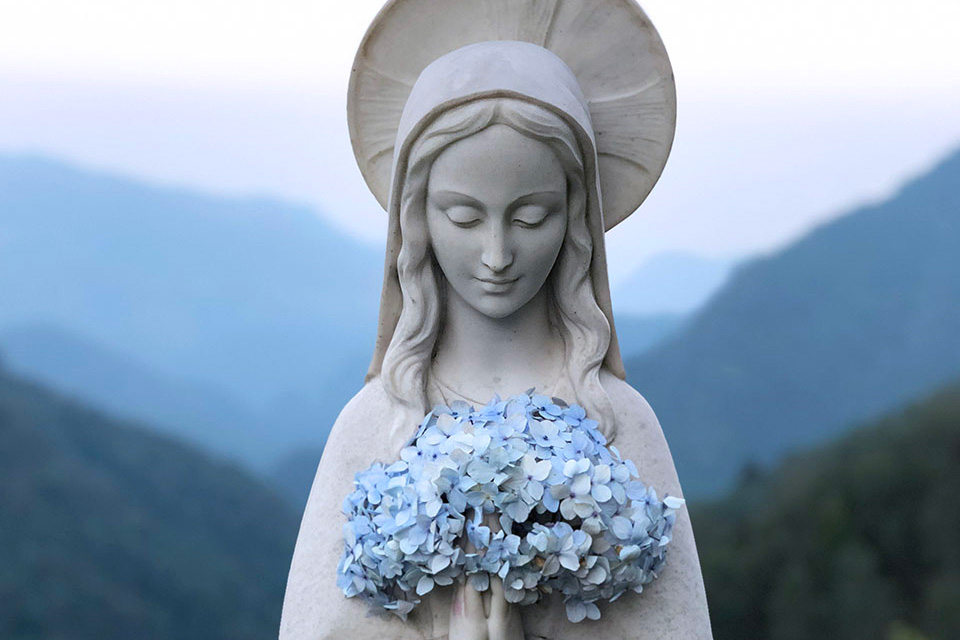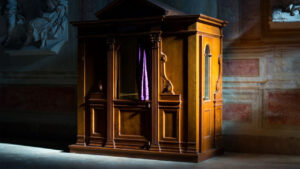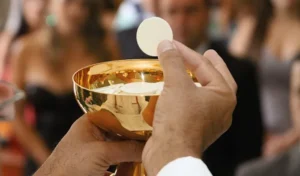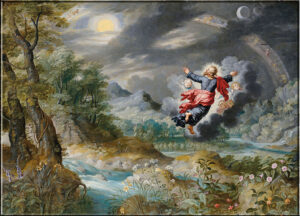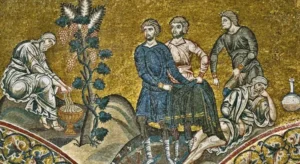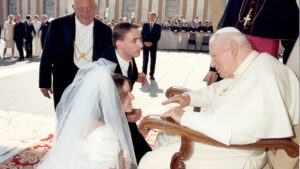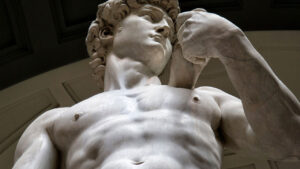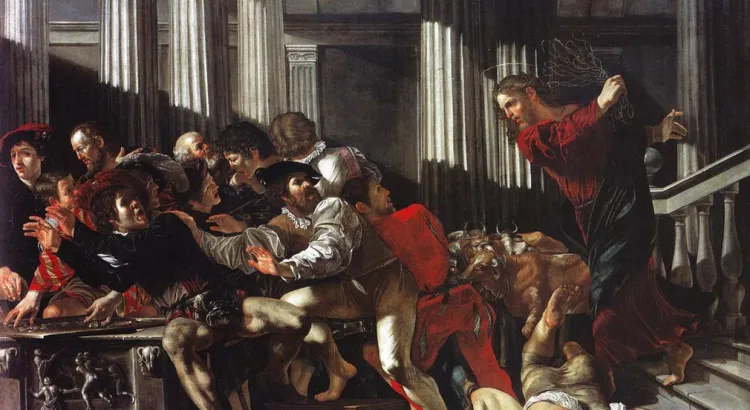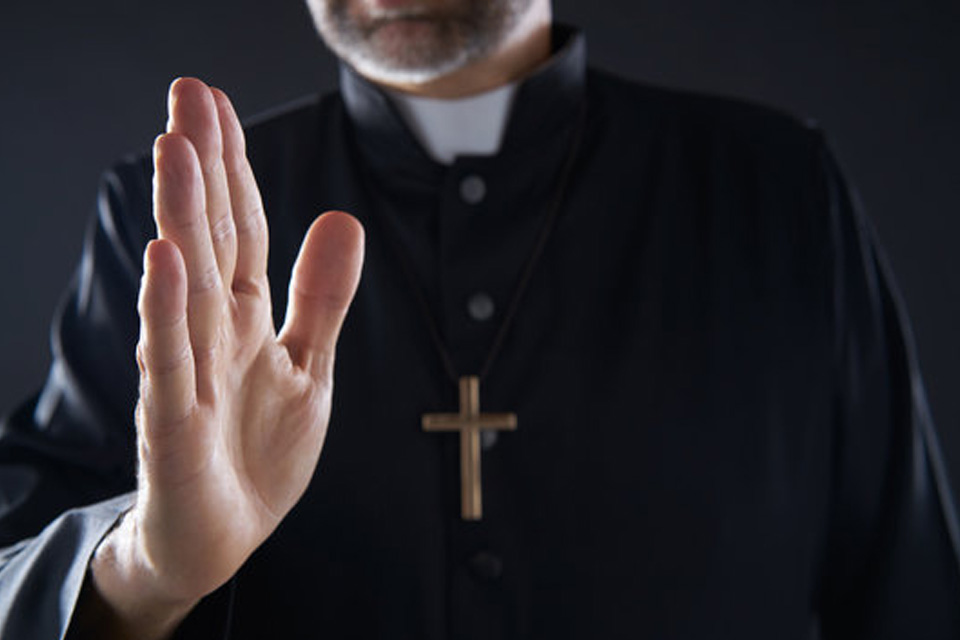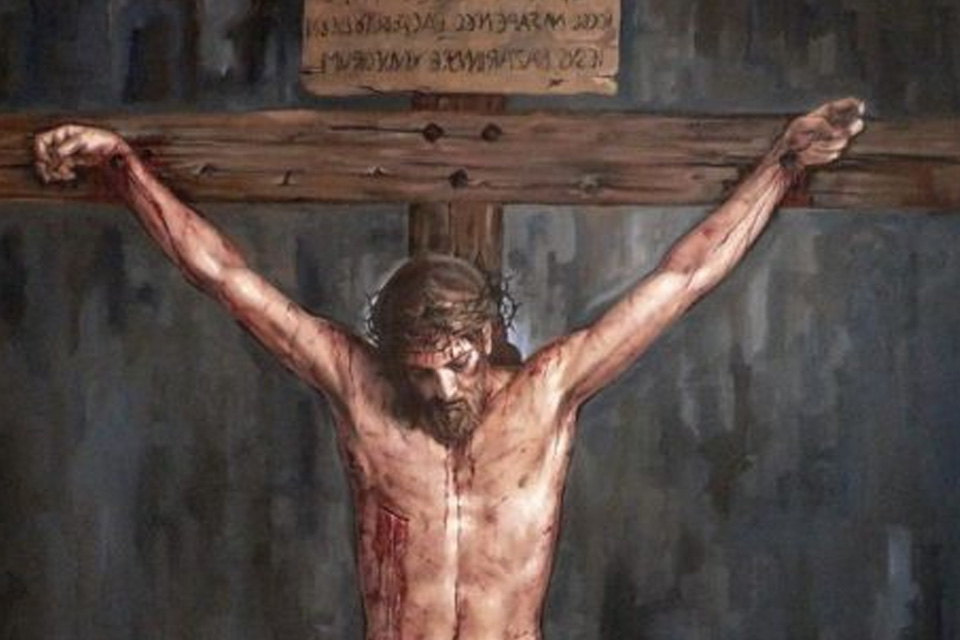Question:
Is it true that Catholics worship images?
Answer:
“Catholics worship statues!” Even though this claim is ridiculous, people continue making this accusation. They say that because Catholics have statues in their churches and pray in front of them, they are violating the commandment of God: “You shall not make for yourself an idol or a likeness of anything in the heavens above or on the earth below or in the waters beneath the earth; you shall not bow down before them or serve them” (Exodus 20:4-5). “This people has committed a grave sin in making a god of gold for themselves” (Exodus 32:31).
This work will examine the arguments of fundamentalists that are ordered against the ancient Christian practice of using images and will provide a biblical reply to those arguments by demonstrating evidence of this practice in the scriptures.
First, we will note that it is correct to warn people against the sin of idolatry. However, the accusation that Catholics are idolaters because they have images of Christ and the Saints is completely wrong. It is based on misunderstanding and ignorance of the teaching of the Bible about the intention and use (both good and bad) of statues.
The anti-Catholic writer Loraine Boettner, in her book Roman Catholicism, declares that it is a sin to have statues because “God has forbidden the use of images in worship” (pg. 281). Many protestants embrace this statement; however, if they “studied the Scriptures” (John 5:39), they would find that the truth is precisely the opposite.
Even though there is no doubt that God condemned the worship of statues, it must be said that He never condemned the use of statues in worship. Even more, He actually recommends their use!
God said to make them
While the Protestants and others cite Exodus 20:4-5 in order to reinforce their accusation that Catholics “worship statues,” they forget the numerous other passages where the Lord orders the carving of statues such as “…make two cherubim of beaten gold for the two ends of the cover; make one cherub at one end, and the other at the other end, of one piece with the cover, at each end. The cherubim shall have their wings spread out above, sheltering the cover with them; they shall face each other, with their faces looking toward the cover” (Exodus 25:18-20).
David gave Solomon a plan that “the refined gold, and its weight, be used for the altar of incense; and finally, gold to fashion the chariot: the cherubim spreading their wings and covering the ark of the covenant of the Lord. All this he wrote down, by the hand of the Lord, to make him understand it—the working out of the whole design” (1 Chronicles 28:18-19). It should be noted that all of this was directed according to the divinely inspired Scriptures. Ezekiel 41:18 describes the engraved images in the temple: “there were figures of cherubim and palm trees: a palm tree between each pair of cherubim.”
The religious use of images
During the plague of serpents that God sent to punish the wicked Israelites, God said to Moses: “Make a seraph and mount it on a pole, and everyone who has been bitten will look at it and recover” (Numbers 21:8-9).
The fact that one should look at the bronze statue of a serpent in order to be healed shows that statues can be used ritually and not merely as religious decorations.
Catholics use statues, paintings, and other artistic objects to remember the person or thing that they represent. In the same way that we may use a photograph to remember our mother, Catholics use images as a way to remember the example of the saints.
Catholics also use statues as teaching tools. In the early Church, they were especially useful for the instruction of illiterate people. Many Protestants themselves have paintings of Jesus and other biblical pictures in their Sunday schools for the purpose of teaching children, especially those who have not yet learned to read. Catholics also use them to commemorate particular people and events similar to the three-dimensional nativity scenes used in Protestant churches. If one measured Protestants with the same rule when using these “printed” images, Protestants would be guilty of practicing the same “idolatry” that they accuse Catholics of practicing. The fact is that, in these cases, they are not acts of idolatry. God prohibits the adoration of images, but does not prohibit the making of images in general. If He did so, all movies, videos, photos, nativity scenes, paintings, drawings and all other kinds of things would be prohibited, since those are also images.
What about genuflection?
Sometimes anti-Catholics cite Deuteronomy 5:9 where God said with respect to statues: “You shall not bow down before them or serve them”. Given that many Catholics bow or kneel in front of statues of Jesus and the saints, anti-Catholics confuse legitimate veneration of a holy image with the sin of idolatry. The reality is that Deutoronomy 5:9 does not help the argument of anti-Catholics.
First, while it is true that genuflection can be used as a posture in worship, not all genuflections are worship. For example, in Japan, it is customary for people to show respect and good manners by bowing in greeting (it is the equivalent of shaking hands in the west). Obviously, there is no type of worship done in this. A Catholic that kneels in front of a statue when he prays is not worshiping or even praying to the statue any more than a Protestant is worshiping or praying to the Bible when he kneels with a Bible in his hands.
When people had to look at the bronze serpent to be cured, they were not worshiping it. This is demonstrated by the fact that, years later, when they began to worship it (and give it the name “Nehushtan”) as a snake-god, the just king Hezekiah destroyed it (2 Kings 18:4).
“Concealing” the second Commandment?
Other positions held by Protestants is that the Catholic Church ‘conceals’ the second Commandment. This is because in the Catholic Catechism the first Commandment is: “You shall not have other gods beside me” (Exodus 20:3) and the second is: “You shall not invoke the name of the Lord, Your God, in vain” (Exodus 20:7). They argue that Catholics have eliminated the prohibition of idolatry in order to be able to justify their use of religious statues.
But this is false. The fact is that Catholics simply grouped the Commandments in a different way than Protestants have traditionally, and have abbreviated themin order to make their memorization easier.
The abbreviation seems reasonable to Protestants as well, which is proven by their translation of the Commandment of the Sabbath as: “Remember to keep holy the Sabbath”, although the actual text of the Commandment is much longer: “Remember the Sabbath day—keep it holy. Six days you may labor and do all your work, but the seventh day is a Sabbath of the Lord your God. You shall not do any work, either you, your son or your daughter, your male or female slave, your work animal, or the resident alien within your gates” (Ex 20:8-11). Martin Luther recognized that the declarations: “You shall not have other gods beside me” (Ex 20:3) and “You shall not make for yourself an idol or a likeness of anything in the heavens above or on the earth below or in the waters beneath the earth” (Ex 20:4) are in reality two parts of the same commandment and is abbreviated as “You shall not have other gods beside me”. The Catechism of the Catholic Church explains that “the division and numbering of the Commandments have varied in the course of history. The present catechism follows the division of the Commandments established by St. Augustine, which has become traditional in the Catholic Church. It is also that of the Lutheran confessions. The Greek Fathers worked out slightly different division, which is found in the Orthodox Churches and the Reformed communities.” (CCC2066)
Other anti-Catholics use Deuteronomy 4:15-18 which says “…be strictly on your guard not to act corruptly fashioning an idol for yourselves to represent any figure, whether it be of a man or a woman…” and try to use this text to “prove” the prohibition of statues and images.
We have demonstrated already that God does not prohibit the making of statues or images of various creatures (ex. angels, serpents, oxen, flowers, lions, etc.) for religious purposes (Cf. 1 Kings 6:29-32; 8:6-67; 2 Chronicles 3:7-14). But what about statues or images that represent God himself? Many Protestants will say that this is wrong because Deuteronomy 4 says that God does not have a form. For this reason, we should not try to make images of Him. But, in reality, does Deuteronomy prohibit images of the Lord?
The answer is NO
From the beginning of their history in Israel, it was forbidden to make representations of God because He had not (yet) revealed Himself in a visible way. If the Israelites had made representations of God, they might have been tempted to worship Him in the form of an animal or some natural object (ex. a bull or the sun) in the same way that the pagans praise them.
But then God did reveal Himself in visible ways as in Daniel 7:9, “As I watched: thrones were set up and the Ancient of Days took his throne. His clothing was white as snow, the hair on his head like pure wool; His throne was flames of fire, with wheels of burning fire.” Protestants make descriptions of the Father in this form when they make illustrations of the Old Testament prophecies.
The Holy Spirit was revealed under two visible form—that of a dove, at the Baptism of Jesus (Mt 3:16, Mk 1:10, Lk 3:22, Jn 1:32)—and as tongues of fire, on the day of Pentecost (Acts 2:1-4). Protestants have used these images (especially that of a dove) when they draw or paint these biblical stories and when using crafts of the Holy Spirit or when they place emblems of doves in their cars.
However, it is very important to note that in the Incarnation of Christ, his Son, God showed mankind as an image of himself. Paul says, “He is the image (in Greek: ikon) of the invisible God, the first born of all creation.” Christ himself is the divine and intangible “image” of the invisible and infinite God of the universe. We read that the Magi “on entering the house saw the child with Mary, his mother. They prostrated themselves and did him homage. They opened their treasures and offered him gifts of gold, frankincense, and myrrh” (Mt 2:11).
The bottom line is that Protestants also use all types of religious images: pictures of Jesus and other Biblical characters appear in a myriad of Bibles, books of Biblical illustrations, jewelry, shirts, stickers, stamps, CDs, and nativity scenes. Christ is symbolically represented by the ictus symbol—the emblem of a “fish”—popular among American evangelicals.
Common sense tells us that, since God has revealed Himself in various images, especially in the Incarnate Jesus Christ, it is revealed to us that it is not bad for us to use the images of these forms in order to strengthen and deepen our knowledge and love of God. This is exactly the purpose of the statues of Jesus and Catholic saints: they are images that represent people that we cannot see with our physical eyes.
Idolatry is condemned by the Church
From the times of the Apostles, the Catholic Church has clearly and consistently condemned the sin of idolatry. The first Fathers of the early Church warned us against this sin and the councils of the Church took on this theme as well. Here are some examples:
The second council of Nicea (787), concerned especially with the question of the veneration of sacred images and icons, said, “He, who redeemed us from the ignorance of the insanity of idolatry, Christ Our Lord, promised protection and assured his holy disciples, when he took as his spouse the Holy Catholic Church, without stain or wrinkle, saying: ‘I will be with you until the last day.” This promise, however, was made not only to them, but also to us, who thanks to them have come to believe in His name. This gratuitous offer was said to have no importance by some, who being attracted by treacherous evil, abandoned the true form of reason…and fell into the incapacity to distinguish the holy from the profane, claiming that the icons of Our Lord and of his saints are no different than the wooden images of the idols of Satanists… Certainly this way of thinking (the worship of images) is not in accord with our faith, which properly gives worship to the divine nature. Although there are some gestures that may seem to have the appearance of worship, like those that honor the figure of the life-giving cross or the holy books of the Evangelists, as well as other sacred objects, they are not worship.’
The Catechism of the Council of Trent (1566) taught that to commit idolatry is “worshiping idols and images as if it were God, or believing that these possess some divinity or virtues that give it the right to receive our adoration, or to elevate our prayers or place our trust in them” (p. 374).
The Catechism of the Catholic Church (1993) explains that “Scripture constantly recalls this rejection of ‘idols of silver and gold, the work of human hands. They have mouths, but they do not speak; eyes, but do not see.’ These empty idols make their worshipers empty: ‘Those who make them are like them; so are all who trust in them’ (Ps 115:4-5, 8). God, however, is the ‘living God’ (Cf. Joshua 3:10; Ps 42:3) who gives life and intervenes in history.”
“Idolatry not only refers to false pagan worship. It remains a constant temptation to the faith. Idolatry consists in divinizing what is not God, whether this be gods or demons (for example, satanism), power, pleasure, race, ancestors, the state, money, etc. Idolatry rejects the unique Lordship of God; it is therefore incompatible with communion with God.”
“Human life finds its unity in the adoration of the one God. The commandment to worship the Lord alone integrates man and saves him from an endless disintegration. Idolatry is a perversion of man’s innate religious sense. An idolater is someone who ‘transfers his indestructible notion of God to anything other than God’” (CCC2122-2114, citing Origen, Contra Celsum 2, 40).
Courtesy of http://apologetica.org/sitio/index.php
Study of the Biblical texts in context
Translated by Fr. Jose Marcone, IVE
Original Post: Here

